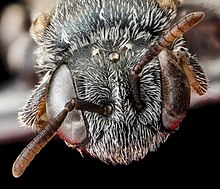Macrotera
| Macrotera | |
|---|---|

| |
| Macrotera latior, female | |
| Scientific classification | |
| Domain: | Eukaryota |
| Kingdom: | Animalia |
| Phylum: | Arthropoda |
| Class: | Insecta |
| Order: | Hymenoptera |
| Family: | Andrenidae |
| Subfamily: | Panurginae |
| Genus: | Macrotera Smith, 1853 |
| Species | |
|
31 | |
Macrotera is a genus of bees native to North America, particularly diverse in the desert regions of the United States and Mexico.[1][2] According to Wilson and Carril, there are "around 30" species of Macrotera.[3] Macrotera are small to medium sized (2.0 mm to 16.0 mm) and often black or reddish in coloration. The genus was treated by P.H. Timberlake who, in addition to T.D.A. Cockerell, described most of the known species. Macrotera used to be considered part of the genus Perdita but was split apart by C.D. Michener in 2000. Most species are extreme specialists (oligoleges) with respect to pollen and will only collect pollen from a few closely related species or genera of plants, paricularly the plant genus Spharalcea and various Cactaceae.
References
- ^ Charles Duncan Michener (2000). The Bees of the World. JHU Press. pp. 283–4. ISBN 978-0-8018-6133-8.
- ^ Snelling, Roy; Danforth, Bryan (1992). "A review of Perdita, subgenus Macrotera" (PDF). Contributions in Science: 1–12. Retrieved 23 April 2017.
- ^ Joseph S. Wilson; Olivia J. Messinger Carril (24 November 2015). The Bees in Your Backyard: A Guide to North America's Bees. Princeton University Press. p. 89. ISBN 978-1-4008-7415-6.
